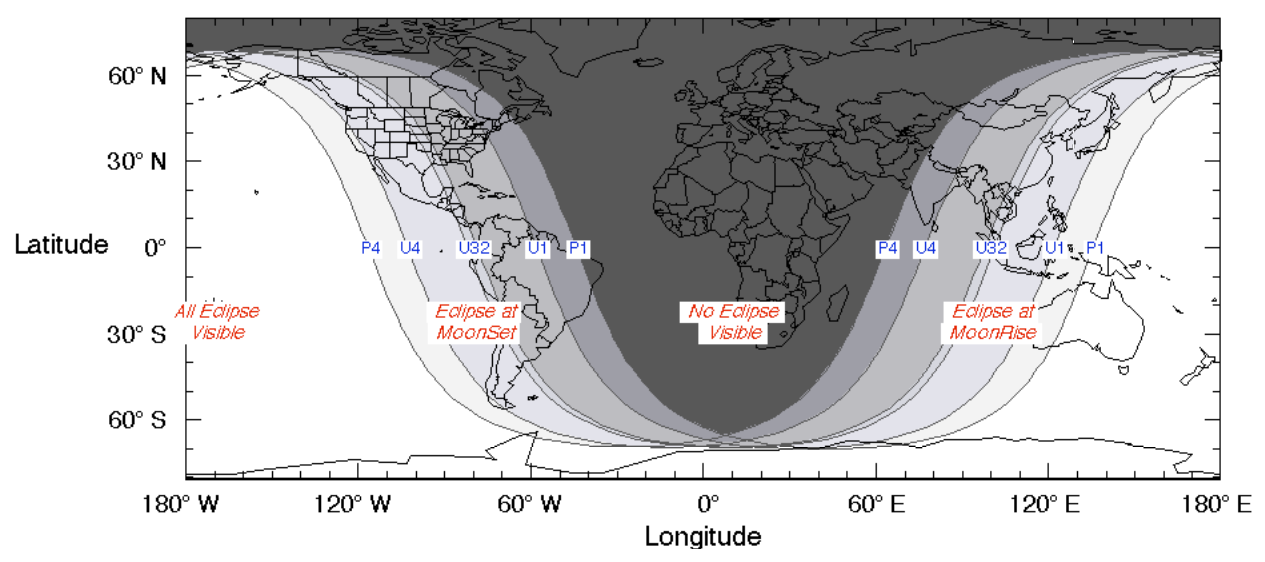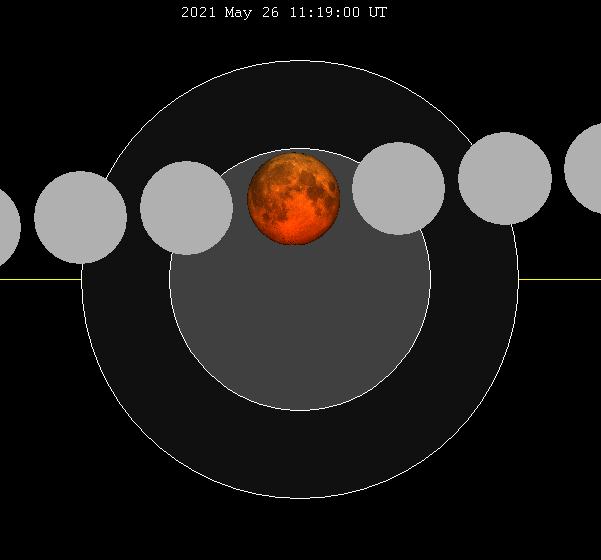THE SOUTHWORTH PLANETARIUM
207-780-4249 www.usm.maine.edu/planet
70 Falmouth Street Portland, Maine 04103
43.6667° N 70.2667° W
Altitude: 10 feet below sea level
Founded January 1970
Julian Date: 2459338.18
2020-2021: CXXII
THE DAILY ASTRONOMER
Monday, May 3, 2021
May 2021 Night Sky Calendar
WEDNESDAY, MAY 26: MOON AT PERIGEE
WEDNESDAY, MAY 26: FULL MOON
Another super moon! For those who might have forgotten, a super moon is defined as a moon that is full at or around the time of perigee, which is at its closest point to Earth. This month, the moon reaches perigee only 9.5 hours before becoming full (reaching opposition.) The super moon is 30% brighter and 14% larger than a micro-moon, defined as the full moon which occurs at or around apogee, the point of greatest distance from Earth. As opposition and perigee are nearly simultaneous, we would have designated this super moon as the gold event, except that...
WEDNESDAY, MAY 26: TOTAL LUNAR ECLIPSE (GOLD EVENT!!!)
"Why on Earth didn't you mention this event a long time ago?'
Well, let's proceed to the next graphic:
We observers in the southern Maine region will only see the moon enter the penumbra as it is setting. Penumbra eclipses are essentially non-events, anyway. The obscuration caused by Earth's outer shadow is slight even under the best conditions. For us, the moon will be low on the horizon, where viewing is not ideal due to the greater quantity of atmospheric gases between outer space and any observer.
If it is any consolation, the full moon will pass through the upper part of Earth's umbra and the total eclipse will be comparatively brief: 14 minutes, 30 seconds.
As another consolation, we will see all of the nearly total lunar eclipse on November 19, 2021.
SATURDAY, MAY 29: MERCURY 0.4 DEGREES SE OF VENUS
One will find Mercury and Venus in the western evening sky tonight. Located about 17 degrees from the Sun, these two planets will set just around 9:30 p.m. This evening, they'll be less than a degree apart. Distinguishing between them will prove quite easy because Venus (magnitude -3.9) will be 300 times brighter than Mercury (magnitude 2.3).
SUNDAY, MAY 30: MOON NEAR SATURN
We'll end the month by seeing the waning gibbous moon (72% illuminated) close to Saturn, the most distant planet visible to the unaided eye/
Saturn and the moon will rise just after midnight and will remain visible for the rest of the evening.
.png%22&N=skychart (1).png)
PLANET WATCH
MERCURY
(Host constellation: Taurus)
One will find the first world in the western evening sky most of the month. Mercury will be difficult to observe at the beginning of May owing to its proximity to the Sun in our sky. However, Mercury becomes easier to find by late May. However, by late month, Mercury will not be particularly bright (around magnitude 2.) VERDICT: It is best to find Mercury late in May. Look on May 30th, when Mercury will appear quite close to Venus.
VENUS
(Host constellation: Taurus)
After a brief hiatus, Venus returns and will become a brilliant late spring/summer evening sky object. Venus will appear close to the Sun early in May, but will draw progressively farther away as the month progresses. VERDICT: As is true with Mercury, Venus will be much easier to find in late May than it will be early in the month.
MARS (PICK PLANET!)
(Host constellation: Gemini)
As one would expect, Mars' reign as the month's pick planet will soon draw to a close now that Venus has moved into the evening sky. However, Mars is May's pick planet because it is easier to find than Venus, at least for now. Mars will set just after midnight early in May; and just before 11:20 p.m. late in the month. Mars maintains a consistent brightness throughout May. At magnitude 1.7, Mars will appear as bright as Alnitak, the western most star in Orion's belt. VERDICT: Although never as bright as Venus, Mars is still easy to find in the western evening sky.
JUPITER
(Host constellation: Aquarius)
One will find Jupiter in the morning sky this month. On May 1st, Jupiter rises just before 3:00 a.m. Each night, Jupiter rises progressively earlier so that it will appear just after 1:00 a.m. by month's end. Jupiter will brighten slightly throughout May, going from magnitude -2.1 on May 1st to -2.3 on May 31st. VERDICT: Early risers will easily see Jupiter in the eastern morning sky this month. If you are up before the Sun, seek out Jupiter in the east. It will appear brighter than any night sky star.
SATURN
(Host constellation: Capricornus)
Saturn rises before Jupiter. At month's beginning, the sixth world will be up around 2:15 a.m. By the end of May, Saturn rises just before midnight. One will see both Jupiter and Saturn in the eastern morning sky throughout May. As Jupiter is currently twelve times brighter than Saturn (magnitude 0.7), one should have no problem telling these two gas giants apart. VERDICT; Although not as brilliant as Jupiter, Saturn will at least be higher in the eastern post-midnight sky than its brighter planetary cohort. Find it to the west of Jupiter.
To subscribe or unsubscribe from the Daily Astronomer:



.png%22&N=skychart (1).png)